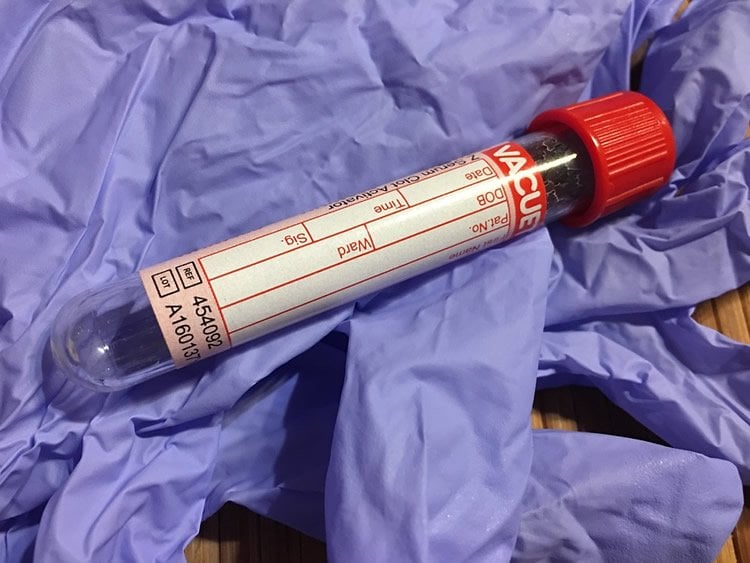Summary: Researchers have developed a new blood test that could help to identify infants who may be experiencing bleeding in the brain as a result of abusive head trauma.
Source: University of Pittsburgh.
Researchers at Children’s Hospital of Pittsburgh of UPMC and University of Pittsburgh School of Medicine have developed and refined a blood test that could help clinicians identify infants who may have had bleeding of the brain as a result of abusive head trauma, sometimes referred to as shaken baby syndrome. The science behind the test is described today in JAMA Pediatrics.
The serum-based test, which needs to be validated in a larger population and receive regulatory approval before being used in clinical practice, would be the first of its kind to be used to detect acute intracranial hemorrhage, or bleeding of the brain. Infants who test positive would then have further evaluation via brain imaging to determine the source of the bleeding.
“Abusive head trauma (AHT) is the leading cause of death from traumatic brain injury in infants and the leading cause of death from physical abuse in the United States,” said senior author Rachel Berger, M.D., M.P.H., chief of the Child Advocacy Center at Children’s Hospital and professor of pediatrics at the Pitt School of Medicine.
However, approximately 30 percent of AHT diagnoses are missed when caretakers provide inaccurate histories or when infants have nonspecific symptoms such as vomiting or fussiness. Missed diagnoses can be catastrophic as AHT can lead to permanent brain damage and even death.
Berger and colleagues at Children’s Hospital and the Safar Center for Resuscitation Research at Pitt’s School of Medicine have long been researching approaches to detect acute intracranial hemorrhage in infants at risk.
In the current study, the researchers collaborated with Axela, a Canadian molecular diagnostics company, to develop a sensitive test that could reduce the chances of a missed diagnosis by using a combination of three biomarkers along with a measure of the patient’s level of hemoglobin, the protein that carries oxygen in blood. Axela’s automated testing system allowed the researchers to measure multiple biomarkers simultaneously using an extremely small amount of blood, an important characteristic of a test designed to be used in infants.
To arrive at the formula, called the Biomarkers for Infant Brain Injury Score (BIBIS), for discriminating between infants with and without intracranial hemorrhage, the team used previously stored serum samples from a databank established at the Safar Center.

The team then evaluated the predictive capacity of the BIBIS value in a second population of 599 infants who were prospectively enrolled at three study sites in the United States. In addition to Children’s Hospital, infants were enrolled at Ann and Robert H. Lurie Children’s Hospital in Chicago and Primary Children’s Hospital in Salt Lake City. The test correctly detected acute intracranial hemorrhage because of abusive head trauma approximately 90 percent of the time, a much higher rate than the sensitivity of clinical judgement, which is approximately 70 percent.
“The test is not intended to replace clinical judgement, which is crucial,” said Dr. Berger. “Rather, we believe that it can supplement clinical evaluation and in cases where symptoms may be unclear, help physicians make a decision about whether an infant needs brain imaging.”
The specificity of the test–or the ability to correctly identify an infant without bleeding of the brain who would not require further evaluation–was 48 percent. The researchers aimed for the test to be highly sensitive rather than maximizing accuracy, since missing a diagnosis has more serious consequences than performing brain imaging in babies without the condition.
“This study illustrates the benefits of being able to perform highly sensitive tests at the point of care,” said Paul Smith, President and CEO of Axela and a co-author of the study.
Additional authors include Janet Fromkin, M.D., Richard Saladino, M.D., and Patrick M. Kochanek, M.D., all from the University of Pittsburgh; Brian J. Pak, Ph.D., Mariya D. Kolesnikova, Ph.D., David Englert, Ph.D., and Paul T. Smith, from Axela Inc., Canada; Bruce E. Herman, M.D., from the University of Utah; and Mary Clyde Pierce, M.D., from Ann and Robert H. Lurie Children’s Hospital.
Funding: The study was funded by National Institutes of Health grants R01HD055986 and NIHK23HD43843. The data in this publication is the basis for patent 62/334,345 filed on May 10, 2016.
Note: Pitt, Dr. Berger and Axela have filed a joint U.S. patent for the test.
Source: Arvind Suresh – University of Pittsburgh
Image Source: NeuroscienceNews.com image is in the public domain.
Original Research: Abstract for “Derivation and Validation of a Serum Biomarker Panel to Identify Infants With Acute Intracranial Hemorrhage” by Rachel Pardes Berger, MD, MPH; Brian J. Pak, PhD; Mariya D. Kolesnikova, PhD; Janet Fromkin, MD; Richard Saladino, MD; Bruce E. Herman, MD; Mary Clyde Pierce, MD; David Englert, PhD; Paul T. Smith; and Patrick M. Kochanek, MD in JAMA Pediatrics. Published online April 10 2017 doi:10.1001/jamapediatrics.2017.0429
[cbtabs][cbtab title=”MLA”]University of Pittsburgh “Blood Test Shows Promise in Detecting Abusive Head Trauma in Infants.” NeuroscienceNews. NeuroscienceNews, 10 April 2017.
<https://neurosciencenews.com/infant-abuse-tbi-6379/>.[/cbtab][cbtab title=”APA”]University of Pittsburgh (2017, April 10). Blood Test Shows Promise in Detecting Abusive Head Trauma in Infants. NeuroscienceNew. Retrieved April 10, 2017 from https://neurosciencenews.com/infant-abuse-tbi-6379/[/cbtab][cbtab title=”Chicago”]University of Pittsburgh “Blood Test Shows Promise in Detecting Abusive Head Trauma in Infants.” https://neurosciencenews.com/infant-abuse-tbi-6379/ (accessed April 10, 2017).[/cbtab][/cbtabs]
Abstract
Derivation and Validation of a Serum Biomarker Panel to Identify Infants With Acute Intracranial Hemorrhage
Importance Abusive head trauma is the leading cause of death from physical abuse. Missing the diagnosis of abusive head trauma, particularly in its mild form, is common and contributes to increased morbidity and mortality. Serum biomarkers may have potential as quantitative point-of-care screening tools to alert physicians to the possibility of intracranial hemorrhage.
Objective To identify and validate a set of biomarkers that could be the basis of a multivariable model to identify intracranial hemorrhage in well-appearing infants using the Ziplex System.
Design, Setting, and Participants Binary logistic regression was used to develop a multivariable model incorporating 3 serum biomarkers (matrix metallopeptidase-9, neuron-specific enolase, and vascular cellular adhesion molecule-1) and 1 clinical variable (total hemoglobin). The model was then prospectively validated. Multiplex biomarker measurements were performed using Flow-Thru microarray technology on the Ziplex System, which has potential as a point-of-care system. The model was tested at 3 pediatric emergency departments in level I pediatric trauma centers (Children’s Hospital of Pittsburgh of University of Pittsburgh Medical Center, Pittsburgh, Pennsylvania; Primary Children’s Hospital, Salt Lake City, Utah; and Lurie Children’s Hospital, Chicago, Illinois) among well-appearing infants who presented for care owing to symptoms that placed them at increased risk of abusive head trauma. The study took place from November 2006 to April 2014 at Children’s Hospital of Pittsburgh, June 2010 to August 2013 at Primary Children’s Hospital, and January 2011 to August 2013 at Lurie Children’s Hospital.
Main Outcomes and Measures A mathematical model that can predict acute intracranial hemorrhage in infants at increased risk of abusive head trauma.
Results The multivariable model, Biomarkers for Infant Brain Injury Score, was applied prospectively to 599 patients. The mean (SD) age was 4.7 (3.1) months. Fifty-two percent were boys, 78% were white, and 8% were Hispanic. At a cutoff of 0.182, the model was 89.3% sensitive (95% CI, 87.7-90.4) and 48.0% specific (95% CI, 47.3-48.9) for acute intracranial hemorrhage. Positive and negative predictive values were 21.3% and 95.6%, respectively. The model was neither sensitive nor specific for atraumatic brain abnormalities, isolated skull fractures, or chronic intracranial hemorrhage.
Conclusion and Relevance The Biomarkers for Infant Brain Injury Score, a multivariable model using 3 serum biomarker concentrations and serum hemoglobin, can identify infants with acute intracranial hemorrhage. Accurate and timely identification of intracranial hemorrhage in infants without a history of trauma in whom trauma may not be part of the differential diagnosis has the potential to decrease morbidity and mortality from abusive head trauma.
“Derivation and Validation of a Serum Biomarker Panel to Identify Infants With Acute Intracranial Hemorrhage” by Rachel Pardes Berger, MD, MPH; Brian J. Pak, PhD; Mariya D. Kolesnikova, PhD; Janet Fromkin, MD; Richard Saladino, MD; Bruce E. Herman, MD; Mary Clyde Pierce, MD; David Englert, PhD; Paul T. Smith; and Patrick M. Kochanek, MD in JAMA Pediatrics. Published online April 10 2017 doi:10.1001/jamapediatrics.2017.0429






